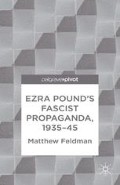Abstract
This chapter sets out the main themes, archival materials and socio-political context bearing upon Ezra Pound’s embrace of fascist ideology in the mid-1930s. It also identifies some of the historical context underpinning Pound’s propaganda for fascism in Britain, Italy and, ultimately, Nazi Germany, while also providing an overview of the ‘new historicist’ methodology to be pursued across Ezra Pound’s Fascist Propaganda, 1935–45.
Access this chapter
Tax calculation will be finalised at checkout
Purchases are for personal use only
Preview
Unable to display preview. Download preview PDF.
Notes
Ezra Pound, Jefferson and/or Mussolini (Stanley Nott, London: 1936 [1935]), 33–34; and Pound, “Anon: ‘Corpses of Course’: Typescript”, 26 January 1945, “Ezra Pound Papers”, Yale University, Beinecke Rare Book and Library, YCAL MSS 43, 130/5425.
War Office cable, 19 September 1943, The National Archives files on Ezra Pound, WO 204/12602; hereafter TNA/WO, 1a. For a good overview of Pound’s 1945 incarceration and subsequent institutionalization, see Noel Stock, The Life of Ezra Pound (Routledge and Kegan Paul: 1970), 408–444; hereafter Stock/LEP.
Pound’s typescript declaration to FBI interrogators, 8 May 1945, TNA/WO, 13aand 13b; available online at: casarrubea.files.wordpress.com/2010/09/pound-depositione-8-maggio-1945.Pdf. See also a longer, more formal statement of 6 May 1945 contained in TNA/WO, 13c–13h, versions of which are reproduced by Noel Stock in Helix 13/14 (1983), 129–132; Richard Sieburth, “Ezra Pound: Confession”, The Paris Review 128 (1993), 194–206;
and Omar S. Pound, Robert E. Spoo, and Dorothy Pound, eds., Ezra and Dorothy Pound: Letters in Captivity, 1945–1946 (Oxford University Press, Oxford: 1999), 59–68.
Zelmira Marazio cited in Christopher Duggan, Fascist Voices: An Intimate History of Mussolini’s Italy (Bodley Head, London: 2012), 189.
For Wyndham Lewis’ phrase in Time and Western Man, and that of Gertrude Stein in The Autobiography of Alice B. Toklas six years later, see Demetres P. Tryphonopoulos and Steven Adams, eds., The Ezra Pound Encyclopedia (Greenwood Press, Westport, CN: 2005), 180 and 281, respectively.
Tim Redman, Ezra Pound Italian Fascism (Cambridge University Press, Cambridge: 1992), 10.; hereafter Redman/EPIF.
Author information
Authors and Affiliations
Copyright information
© 2013 Matthew Feldman
About this chapter
Cite this chapter
Feldman, M. (2013). Introduction. In: Ezra Pound’s Fascist Propaganda, 1935–45. Palgrave Pivot, London. https://doi.org/10.1057/9781137345516_1
Download citation
DOI: https://doi.org/10.1057/9781137345516_1
Publisher Name: Palgrave Pivot, London
Print ISBN: 978-1-349-46653-5
Online ISBN: 978-1-137-34551-6
eBook Packages: Palgrave History CollectionHistory (R0)

